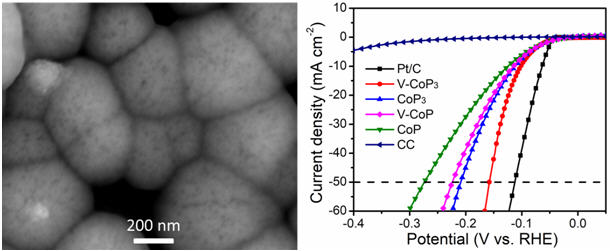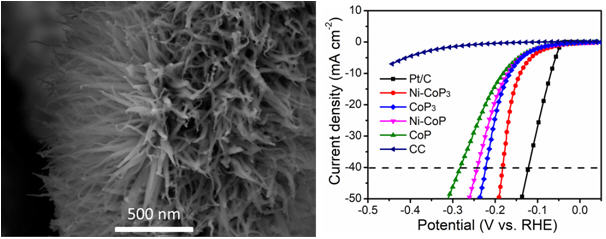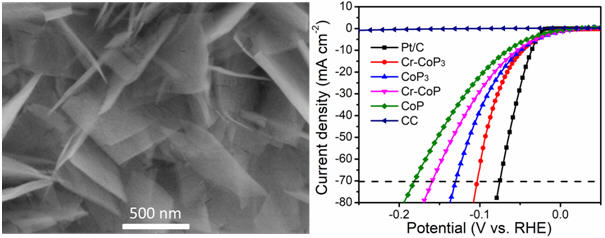A metal-doped cop 3 , its preparation method and application
A metal doping and reaction kettle technology, applied in chemical instruments and methods, chemical/physical processes, physical/chemical process catalysts, etc., can solve the problem of low intrinsic activity of cobalt triphosphide electrocatalytic hydrogen evolution, etc. The effect of catalytic hydrogen evolution activity and stability
- Summary
- Abstract
- Description
- Claims
- Application Information
AI Technical Summary
Problems solved by technology
Method used
Image
Examples
Embodiment 1
[0034] In this embodiment, self-supporting growth of vanadium-doped cobalt triphosphide nanosphere electrode on flexible carbon cloth and electrocatalytic hydrogen evolution test include the following steps:
[0035] Step 1: Soak the flexible carbon cloth in dilute nitric acid with a mass fraction of 15% for two hours to protonize it, then take out the flexible carbon cloth and wash it three times with water and anhydrous, and dry it for later use.
[0036]In the second step, 1.309g of cobalt nitrate hexahydrate, 0.136g of vanadium sulfate heptahydrate and 0.2g of ammonium nitrate were successively dissolved in 15mL of water, stirred at room temperature for 60 minutes to obtain a uniform solution, and then 5mL of ammonia water with a mass fraction of 25wt% was added to the above The solution was stirred for thirty minutes to obtain a homogeneous solution.
[0037] The third step is to transfer the homogeneous solution in the previous step into a 25mL polytetrafluoroethylene re...
Embodiment 2
[0041] In this embodiment, the self-supporting growth of chromium-doped cobalt triphosphide nanowire array electrode on flexible carbon cloth and the electrocatalytic hydrogen evolution test include the following steps
[0042] Step 1: Soak the flexible carbon cloth in dilute nitric acid with a mass fraction of 15% for two hours to protonize it, then take out the flexible carbon cloth and wash it with water and alcohol for three times and dry it for later use.
[0043] Step 2: Dissolve 0.523g of cobalt nitrate hexahydrate, 0.078g of chromium sulfate, 0.186g of ammonium fluoride and 0.6g of urea in 40mL of ultrapure water in sequence, and stir at room temperature for 30 minutes to obtain a uniform solution.
[0044] Step 3: Transfer the uniform solution into a 50mL polytetrafluoroethylene reactor liner, put the dry spare flexible carbon cloth vertically into the reactor liner, seal the reactor well, and conduct a hydrothermal reaction at 120°C for 6 hours. The carbon cloth was ...
Embodiment 3
[0048] In this embodiment, self-supporting growth of nickel-doped cobalt triphosphide nanosheet array electrode on flexible carbon cloth and electrocatalytic hydrogen evolution test include the following steps
[0049] Step 1: Soak the flexible carbon cloth in dilute nitric acid with a mass fraction of 15% for two hours to protonize it, then take out the flexible carbon cloth and wash it three times with water and absolute ethanol to dry it for later use.
[0050] Step 2: Dissolve 2.095g of cobalt nitrate hexahydrate, 0.233g of nickel nitrate hexahydrate, 0.106g of ammonium fluoride and 1.2g of urea in 40mL of ultrapure water, and stir at room temperature for 60 minutes to obtain a uniform solution.
[0051] Step 3: Transfer the uniform solution into a 50mL polytetrafluoroethylene reactor liner, and put the washed dry spare flexible carbon cloth vertically into the reactor liner, seal the reactor, and heat it at 120°C After reacting for 22 hours, the carbon cloth was taken out...
PUM
| Property | Measurement | Unit |
|---|---|---|
| diameter | aaaaa | aaaaa |
| quality score | aaaaa | aaaaa |
Abstract
Description
Claims
Application Information
 Login to View More
Login to View More - R&D
- Intellectual Property
- Life Sciences
- Materials
- Tech Scout
- Unparalleled Data Quality
- Higher Quality Content
- 60% Fewer Hallucinations
Browse by: Latest US Patents, China's latest patents, Technical Efficacy Thesaurus, Application Domain, Technology Topic, Popular Technical Reports.
© 2025 PatSnap. All rights reserved.Legal|Privacy policy|Modern Slavery Act Transparency Statement|Sitemap|About US| Contact US: help@patsnap.com



